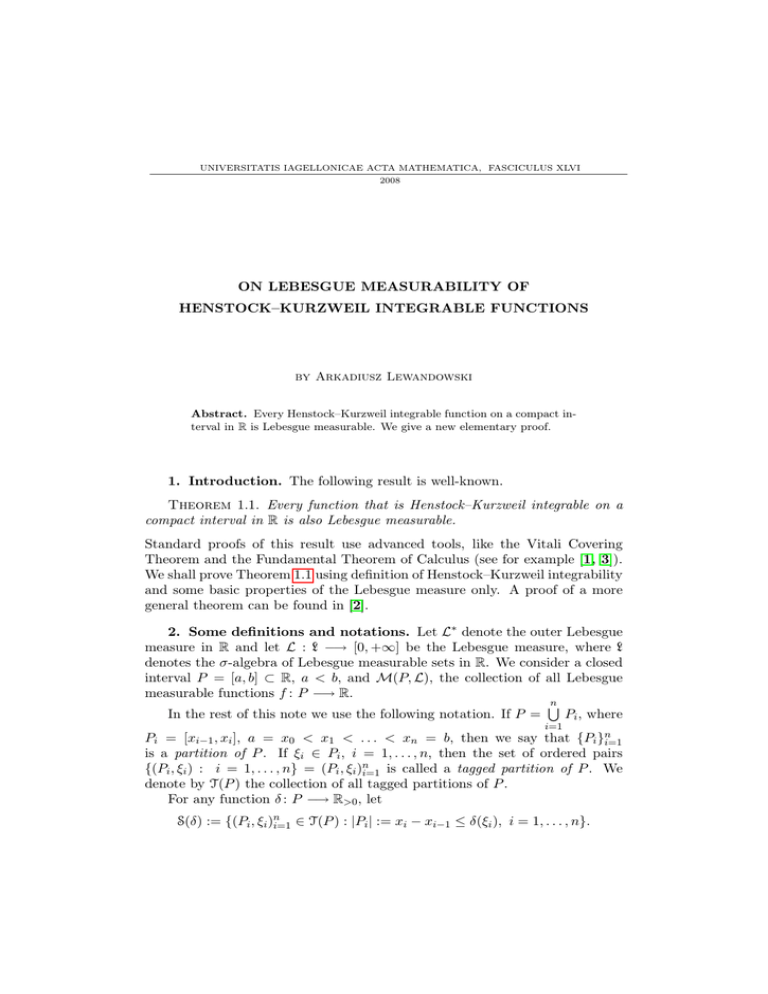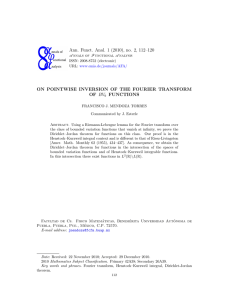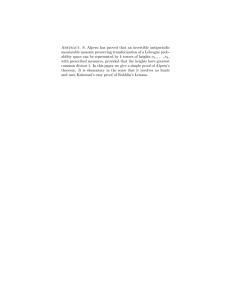ON LEBESGUE MEASURABILITY OF HENSTOCK–KURZWEIL INTEGRABLE FUNCTIONS by Arkadiusz Lewandowski
advertisement

UNIVERSITATIS IAGELLONICAE ACTA MATHEMATICA, FASCICULUS XLVI
2008
ON LEBESGUE MEASURABILITY OF
HENSTOCK–KURZWEIL INTEGRABLE FUNCTIONS
by Arkadiusz Lewandowski
Abstract. Every Henstock–Kurzweil integrable function on a compact interval in R is Lebesgue measurable. We give a new elementary proof.
1. Introduction. The following result is well-known.
Theorem 1.1. Every function that is Henstock–Kurzweil integrable on a
compact interval in R is also Lebesgue measurable.
Standard proofs of this result use advanced tools, like the Vitali Covering
Theorem and the Fundamental Theorem of Calculus (see for example [1, 3]).
We shall prove Theorem 1.1 using definition of Henstock–Kurzweil integrability
and some basic properties of the Lebesgue measure only. A proof of a more
general theorem can be found in [2].
2. Some definitions and notations. Let L∗ denote the outer Lebesgue
measure in R and let L : L −→ [0, +∞] be the Lebesgue measure, where L
denotes the σ-algebra of Lebesgue measurable sets in R. We consider a closed
interval P = [a, b] ⊂ R, a < b, and M(P, L), the collection of all Lebesgue
measurable functions f : P −→ R.
n
S
In the rest of this note we use the following notation. If P =
Pi , where
i=1
Pi = [xi−1 , xi ], a = x0 < x1 < . . . < xn = b, then we say that {Pi }ni=1
is a partition of P . If ξi ∈ Pi , i = 1, . . . , n, then the set of ordered pairs
{(Pi , ξi ) : i = 1, . . . , n} = (Pi , ξi )ni=1 is called a tagged partition of P . We
denote by T(P ) the collection of all tagged partitions of P .
For any function δ : P −→ R>0 , let
S(δ) := {(Pi , ξi )ni=1 ∈ T(P ) : |Pi | := xi − xi−1 ≤ δ(ξi ), i = 1, . . . , n}.
74
Definition 2.1. We say that a function f : P −→ R is Henstock–Kurzweil
integrable on P if there exists a number I ∈ R such that for every ε > 0 there
exists a function δ : P −→ R>0 such that if (Pi , ξi )ni=1 ∈ S(δ), then
n
X
f (ξi )|Pi | − I ≤ ε.
i=1
In
R this case we say that I is the Henstock–Kurzweil integral of f and put
P f := I. We denote by HK(P ) the collection of all Henstock–Kurzweil
integrable functions on P .
3. Proof of Theorem 1.1. First we shall show that if the following
lemma holds true, then we can prove Theorem 1.1.
Lemma 3.1. If f ∈
/ M(P, L), then there exist an A ∈ L such that
0 < L(A) < ∞ and numbers α < β such that L∗ (A ∩ {f ≤ α}) = L∗ (A ∩
{f ≥ β}) = L(A).
Indeed, assume for a while that Lemma 3.1 holds.
Proof of Theorem 1.1. Without loss of generality, assume that
P = [0, 1]. Fix an f ∈ HK(P ). Suppose that f ∈
/ M(P, L). Then, by Lemma
3.1, we find an A ∈ L such that 0 < L(A) < ∞, and numbers α < β such that
L∗ (A ∩ {f ≤ α}) = L∗ (A ∩ {f ≥ β}) = L(A).
2ε
+ 2ε. Let δ : P −→ R>0 be such that
Fix an ε > 0 satisfying L(A) > β−α
Z n
X
f (ξi )|Pi | −
f ≤ ε for every (Pi , ξi )ni=1 ∈ S(δ).
i=1
P
Define
Am := A ∩ {f ≤ α} ∩ {x ∈ P :
Bm := A ∩ {f ≥ β} ∩ {x ∈ P :
1
m
1
m
≤
≤
δ(x)
2 },
δ(x)
2 },
m ∈ N, m 6= 0.
Then there exists an m0 ≥ 1 such that L∗ (Am0 ) ≥ L(A) − ε and
≥ L(A) − ε.
Indeed, suppose that L∗ (Am ) < L(A) − ε for every m ∈ N, m 6= 0. Thanks
to the regularity of L, for every m ∈ N, m 6= 0, there exists a Cm ∈ L such
that L(Cm ) = L∗ (Am ) and Am ⊂ Cm ⊂ A. We may assume that the sequence
{Cm }∞
m=1 is increasing.
To see this, for given C1 , C2 , . . . define Djm := Cm \ Cj , m ∈ N, m 6= 0,
∞
S
0
0
j ≥ m + 1, and Cm := Cm \
Djm . Then {Cm }∞
m=1 is increasing and
L∗ (Bm0 )
j=m+1
0
0
Am ⊂ Cm ⊂ A, as well as L(Cm ) = L(Cm ) = L∗ (Am ).
75
∞
S
Finally we obtain L(
Cm ) ≤ L(A) − ε, but A ∩ {f ≤ α} ⊂
m=1
∞
S
which implies L(A) = L(
∞
S
Cm ⊂ A,
m=1
Cm ); a contradiction. Thus, there exists an
m=1
m1 ≥ 1 such that L∗ (Am1 ) ≥ L(A) − ε. Analogously, there exists an m2 ≥ 1
such that L∗ (Bm2 ) ≥ L(A) − ε.
Then m0 := max{m1 , m2 }.
1
Define δ 0 := min{δ, 2m
}. Fix an (Pi , ξi )ni=1 ∈ S(δ 0 ) and finally let
0
I2 := {i ∈ {1, . . . , n} : Pi ∩Bm0 = ∅},
I1 := {i ∈ {1, . . . , n} : Pi ∩Am0 = ∅},
I3 := {1, . . . , n} \ (I1 ∪ I2 ).
S
We see that L(A∩
Pi ) ≤ L(A)−L(A∩(
Pi )c ) ≤ L(A)−L∗ (Am0 ) ≤ ε
i∈I1
i∈I1
S
P
and similarly L(A ∩
Pi ) ≤ ε. For i ∈ I3 , there is
|Pi | ≥ L(A) − 2ε and
S
i∈I2
i∈I3
Pi ∩ Am0 6= ∅, Pi ∩ Bm0 6= ∅, so. Thus, for i ∈ I3 , we find ξi0 ∈ Pi ∩ Am0 ,
ξi00 ∈ Pi ∩ Bm0 . For i ∈
/ I3 , let ξi = ξi0 = ξi00 . Consider tagged partitions
0
n
00
n
(Pi , ξi )i=1 , (Pi , ξi )i=1 . We observe that (Pi , ξi0 )ni=1 , (Pi , ξi00 )ni=1 ∈ S(δ) (1 ). Now,
since f is integrable, we get
n
n
X
X
0
f (ξi )|Pi | −
f (ξi00 )|Pi | ≤ 2ε.
i=1
i=1
n
n
X
X
X
On the other hand, f (ξi0 )|Pi | −
f (ξi00 )|Pi | =
(f (ξi00 ) − f (ξi0 ))|Pi | and
i=1
X
i=1
(f (ξi00 ) − f (ξi0 ))|Pi | ≥ (β − α)
i∈I3
X
i∈I3
|Pi | ≥ (β − α)(L(A) − 2ε) > 2ε,
i∈I3
which is a contradiction.
To prove Lemma 3.1, suppose for a while that the following lemma holds.
Lemma 3.2. For every A ∈
/ L there exists a B ∈ L such that A ⊂ B and
L∗ (A ∩ C) = L(B ∩ C) for every C ∈ L (then we will write B ∈ AL ).
Proof of Lemma 3.1. Step 1. If B ∈
/ L, then there exists a D ∈ L such
that 0 < L(D) < ∞ and L∗ (D ∩ B) = L∗ (D \ B) = L(D).
1
1
m0
For example: since |Pi | ≤ δ 0 (ξi ), then |Pi | ≤
≤
δ(ξi0 )
2
. Therefore, |Pi | ≤
δ(ξi0 )
and
(Pi , ξi0 )n
i=1
1
,
2m0
∈ S(δ).
i = 1, . . . , n. For i ∈ I3 , there is
76
Indeed, there exists a C ∈ L of finite measure such that B ∩ C ∈
/ L. Thanks
L
to Lemma 3.2, we find A1 , A2 ∈ L such that A1 ∈ (B ∩ C) , A2 ∈ (C \ B)L .
Then
C \ A2 ⊂ C ∩ B ⊂ C ∩ A1 .
(1)
Consider D := (C ∩ A1 ) \ (C \ A2 ) = C ∩ A1 ∩ A2 ∈ L. Then (1) and the fact
that the Lebesgue measure is complete implies L(D) > 0. Also, L(D) < ∞,
because D ⊂ C. Finally, L∗ (D ∩ B) = L∗ (D ∩ C ∩ B) = L(D ∩ A1 ) = L(D)
and L∗ (D \ B) = L∗ (D ∩ (C \ B)) = L(D ∩ A2 ) = L(D).
Step 2. Choose an f ∈
/ M(P, L). Then there exists an α ∈ R such that
{f ≤ α} ∈
/ L. From Step 1, we find a D ∈ L such that 0 < L(D) < ∞ and
L∗ (D ∩ {f ≤ α}) = L∗ (D \ {f ≤ α}) = L(D). Thus, D ∈ (D ∩ {f ≤ α})L .
Consider an increasing family of sets A := {D ∩ {f ≥ α + 21n }}n∈N . Then
S
A = D \{f ≤ α}. Thus, there exists a β > α for which L∗ (D ∩{f ≥ β}) > 0.
We find a measurable set A ⊂ D such that D∩{f ≥ β} ⊂ A and L(A) = L∗ (D∩
{f ≥ β}). Finally, L∗ (A∩{f ≤ α}) = L∗ (A∩D∩{f ≤ α}) = L(A∩D) = L(A)
and L∗ (A ∩ {f ≥ β}) = L∗ (D ∩ {f ≥ β}) = L(A).
It remains to prove Lemma 3.2.
Proof of Lemma 3.2. Step 1. If A ⊂ B ∈ L, then B ∈ AL iff for every
D ∈ L satisfying D ⊂ B \ A there is L(D) = 0.
Assume first that B ∈ AL and fix a measurable set D ⊂ B \ A. Then
L(D) = L(B ∩ D) = L∗ (A ∩ D) = 0.
Conversely, assume that for every measurable set D ⊂ B \ A there holds
L(D) = 0. Suppose, seeking a contradiction, that B ∈
/ AL . Then there exists a
∗
C ∈ L such that L (A∩C) < L(B∩C). Choose a set D ∈ L satisfying A∩C ⊂ D
and L(D) = L∗ (A ∩ C). Let E := (B ∩ C) \ D. Then L(D) < L(B ∩ C),
which implies L(E) > 0. Obviously, E ∈ L. But we have also E ⊂ B and
A ∩ E ⊂ (A ∩ C) \ D = ∅; a contradiction.
Step 2. If A ⊂
∞
S
An , where An ∈ L and L(An ) < ∞, n = 1, 2, . . . ,
n=1
then there exists a set from AL . Indeed, thanks to the regularity of L, for
every n = 1, 2, . . . , there exists a Bn ∈ L such that A ∩ An ⊂ Bn and
L(Bn ) = L∗ (A ∩ An ). In fact, Bn ∈ (A ∩ An )L .
To see this, choose a measurable set D ⊂ Bn \ (A ∩ An ). Then (A ∩ An ) ⊂
Bn \ D, hence L(Bn \ D) = L(Bn ). But L(Bn ) < ∞, thus L(D) = 0 and Step
1 implies Bn ∈ (A ∩ An )L .
∞
S
Let B =
Bn . Obviously, A ⊂ B. Moreover, if we take a measurable set
n=1
77
D ⊂ B \ A, then D ∩ Bn ⊂ Bn \ (A ∩ An ). Therefore, from Step 1 there follows
∞
S
L(D ∩ Cn ) = 0, so D =
D ∩ Bn is of measure zero and Step 1 completes
n=1
the proof of Step 2.
Step 3. Every set in R satisfies the assumption of Step 2.
Theorem 1.1 is proved.
Acknowledgements. I am grateful to Professor Marek Jarnicki for his
patience and valuable remarks.
References
1. Bartle R. G., A Modern Theory of Integration, American Mathematical Society, Providence, 2001.
2. Fremlin D. H., Measure theory, Vol. 4: Topological measure spaces, Part II, Torres Fremlin,
Colchester, 2006.
3. Pfeffer W. F., The Riemann approach to integration: local geometric theory, Cambridge
University Press, Cambridge, 1993.
Received
June 6, 2008
Institute of Mathematics
Jagiellonian University
ul. Lojasiewicza 6
30-348 Kraków, Poland
e-mail : arkadiuslewandowski@wp.pl







